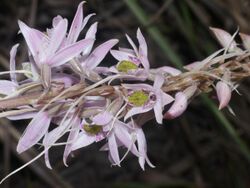Biology:Pachystoma pubescens
| Pink kunai orchid | |
|---|---|

| |
| Pachystoma pubescens in the Namdapha Tiger Reserve | |
| Scientific classification | |
| Kingdom: | Plantae |
| Clade: | Tracheophytes |
| Clade: | Angiosperms |
| Clade: | Monocots |
| Order: | Asparagales |
| Family: | Orchidaceae |
| Subfamily: | Epidendroideae |
| Genus: | Pachystoma |
| Species: | P. pubescens
|
| Binomial name | |
| Pachystoma pubescens | |
| Synonyms[1] | |
|
Pachychilus pubescens (Blume) Blume | |
Pachychila pubescens, commonly known as pink kunai orchid[2] or as 粉口兰 (fen kou lan),[3] is a plant in the orchid family. It is native to areas from Asia through Southeast Asia to New Guinea and northern Australia . It is a deciduous, terrestrial herb with one or two grass-like leaves and up to ten dull pink, more or less drooping flowers. It grows in wet, grassy places in forests and woodlands.
Description
Pachystoma pubescens is a deciduous, terrestrial herb with one or two dark green, linear, pleated, sharply pointed leaves 300–450 mm (12–18 in) long and 8–10 mm (0.3–0.4 in) wide. Between four and ten resupinate, dull pink, more or less tubular, drooping flowers 10–12 mm (0.4–0.5 in) long and 4–5 mm (0.16–0.20 in)wide are borne on a flowering stem 300–600 mm (10–20 in) tall. The dorsal sepal is 10–12 mm (0.4–0.5 in) long, about 4 mm (0.2 in) wide and the lateral sepals are a similar length but 5–6 mm (0.20–0.24 in) wide with a humped base. The petals are a similar length to the sepals but narrower. The labellum is 10–12 mm (0.4–0.5 in) long and 6–8 mm (0.2–0.3 in) wide with three lobes. The middle lobe has a square tip and pimply surface and the side lobes curve upwards. Flowering occurs in November and December in Australia and March to September in Asia.[2][3][4][5]
Taxonomy and naming
Pachystoma pubescens was first described in 1825 by Carl Ludwig Blume, in his Bijdragen tot de Flora van Nederlandsch Indie.[6][7] The specific epithet (pubescens) is derived from the Latin word pubesco meaning "put on the down of puberty"[8]:392 with the ending -escens meaning "beginning of" or "becoming",[8]:135 hence "pubescent".[8]:392
Distribution and habitat
The pink kunal orchid often grows with grasses such as kunai grass (Imperata cylindrica) in woodland and forest areas that are seasonally wet. It occurs in China , Bangladesh, Bhutan, Cambodia, India , Indonesia, Laos, Malaysia, Myanmar, New Guinea, the Philippines , Vietnam and in Australia where it is found in northern parts of the Northern Territory and in Tropical North Queensland.[2][3]
References
| Wikimedia Commons has media related to Pachystoma pubescens. |
- ↑ 1.0 1.1 "Pachystoma pubescens". World Checklist of Selected Plant Families (WCSP). Royal Botanic Gardens, Kew. http://wcsp.science.kew.org/namedetail.do?name_id=145381.
- ↑ 2.0 2.1 2.2 Jones, David L. (2006). A complete guide to native orchids of Australia including the island territories. Frenchs Forest, N.S.W.: New Holland. pp. 360–361. ISBN 1877069124.
- ↑ 3.0 3.1 3.2 "Pachystoma pubescens". Flora of China. http://www.efloras.org/florataxon.aspx?flora_id=2&taxon_id=200028783. Retrieved 28 October 2018.
- ↑ "Factsheet - Pachystoma pubescens". Centre for Australian National Biodiversity Research (CANBR), Australian Government. 2010. http://www.canbr.gov.au/cpbr/cd-keys/RFKOrchids/key/rfkorchids/Media/Html/Pachystoma_pubescens.htm.
- ↑ "Pachystoma pubescens". Orchids of New Guinea. http://www.orchidsnewguinea.com/orchid-information/species/speciescode/653. Retrieved 28 October 2018.
- ↑ "Pachystoma pubescens". APNI. https://id.biodiversity.org.au/instance/apni/541448. Retrieved 28 October 2018.
- ↑ Blume, Carl Ludwig (1825). Bijdragen tot de Flora van Nederlandsch Indi. Batavia. p. 376. https://www.biodiversitylibrary.org/item/9224#page/94/mode/1up. Retrieved 28 October 2018.
- ↑ 8.0 8.1 8.2 Brown, Roland Wilbur (1956). The Composition of Scientific Words. Washington, D.C.: Smithsonian Institution Press.
Wikidata ☰ Q15246869 entry
 |

